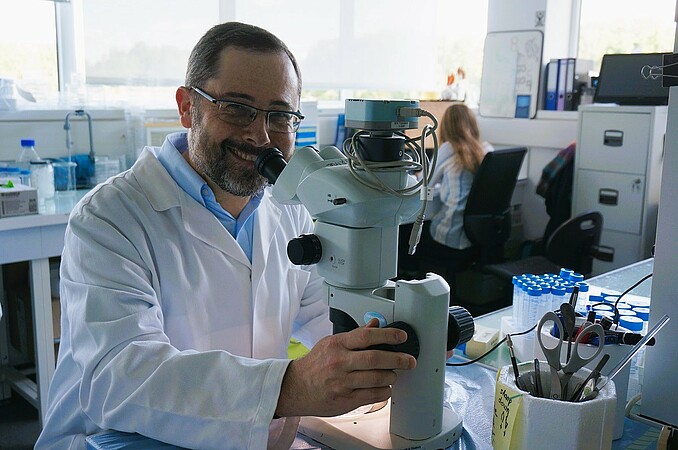
搜索网站、位置和人员

新闻与活动 活动信息
交叉科学中心系列讲座CIS Seminar Series | Self-organisation of organoids: experiments and theory
时间
2025年5月13日(周二)
下午16:00-17:30
地点
西湖大学云谷校区学术环E10-315
主持
西湖大学交叉科学中心讲席教授汤雷翰
受众
全体师生
分类
学术与研究
交叉科学中心系列讲座CIS Seminar Series | Self-organisation of organoids: experiments and theory
时间:2025年5月13日(周二)下午16:00-17:30
Time: 16:00-17:30, Tuesday, May 13, 2025
主持人: 西湖大学交叉科学中心讲席教授汤雷翰
Host: Dr. Leihan Tang, Chair Professor, the Center for Interdisciplinary Studies
地点:西湖大学云谷校区学术环E10-315
Venue: E10-315, Yungu Campus
讲座语言:英文
Lecture Language: English

Prof. Daniel Riveline
Université de Strasbourg, CNRS, IGBMC, France
主讲人/Speaker:
Dr. Riveline is an experimental biophysicist who probes self-organisation phenomena in living matter using physics and quantitative biology. He and his team revealed the mechanosensing of focal contacts and cell-cell contacts, or how cellular adhesive contacts reinforce themselves when cells apply local forces. These results have opened new routes to study the interplay between cytoskeleton mechanics and its Rho GTPase regulation. He also reported a new type of cell migration, ratchetaxis or directed cell motion in the absence of long-range chemical gradients, with a potential impact on understanding cell motion during development and in cancer.
After receiving his PhD in physics in 1997 from the Institut Curie in Paris (France), Daniel Riveline took up a post-doctoral position in biology at the Weizmann Institute of Science (Israel). In 1999, he started his group at the University of Grenoble (France) where he established mechanosensing of contacts with the extracellular matrix and between cells. In 2010, after a sabbatical in biology at Rockefeller University (United States) where he managed to inject fission yeast for the first time and to characterize cytokinesis ring closure, he relocated to the University of Strasbourg to establish a group in cell physics at the Institute of Supramolecular Science and Engineering (ISIS). He then moved to IGBMC in 2015, where he continues his research activities on self-organisation in living matter.
讲座摘要/Abstract:
Understanding how out of single cells functional tissues and organs develop is a major challenge of biology. Recent progress allows us to grow organ-like cell assemblies (organoids) from stem cells in vitro. Organoids offer great potential for studying diseases and development. However, in many cases we do not yet understand how these complex tissues emerge out of progenitor or stem cells. A common feature in the initial growth phase of many organoid systems is the formation of a polarised epithelial cyst with a single or multiple internal apical lumen. This initial transition into an epithelial cyst establishes a tissue template that enables maintenance of progenitor/stem cells (niche) and guides the patterning of differentiated cells into a functional tissue. Our aim was to understand how the interplay between luminal pressure, proliferation (cell divisions), polarisation (epithelial transition) and differentiation (patterning) leads to self-organisation of this epithelial progenitor template and how this structure facilitates correct patterning into functional organoids. To this end, we systematically controlled and characterised the early growth phase of two organoid systems (pancreatic and neural tube) and MDCK cysts using numerical simulation, microfabrication, micromanipulations, and mechanical measurements. We used phase field models to compute the phenotypes of organoids with simple growth rules and luminal pressure. The resulting phase diagrams were assessed by experimental measurements, which confirmed the importance of proliferation rate and luminal pressure for luminal shape and number. By regulating tight junction protein expression, and thereby luminal pressure, we showed how cysts can adopt distinct phenotypes in their apical sides. We demonstrated that epiblasts formed lumens for a critical number of cells and this was consistent with a minimal model. By controlling initial cell number at plating, we reported how the mechanisms of lumen formation and their fusions were shared between all systems. By traveling in the phase diagram with pancreatic organoids and MDCK cysts, we tested the predicted phenotypes and the experimental shapes. These integrated results using a common theoretical framework show that organoids obey simple and generic rules of self-organisation.
理学院,徐恺吟,邮箱:xukaiyin@westlake.edu.cn
School of Science, Kaiyin Xu, Email: xukaiyin@westlake.edu.cn

















